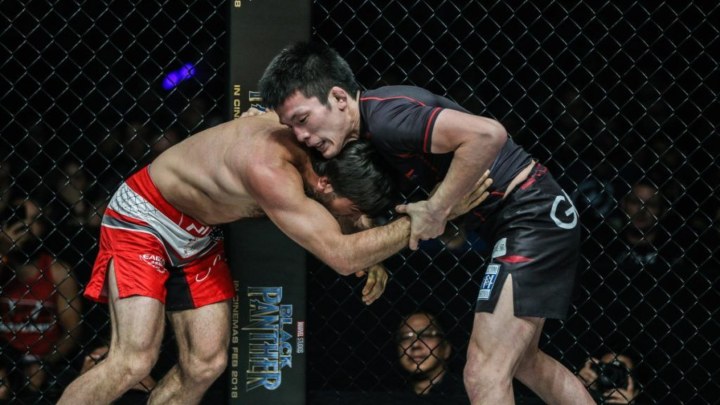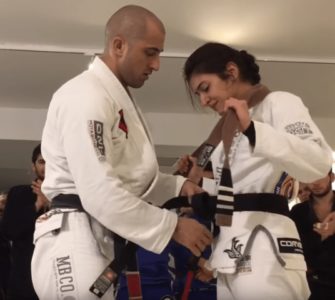Guest post by Evolve MMA, Asia’s premier championship brand for martial arts. It has the most number of World Champions on the planet. Named as the #1 ranked martial arts organization in Asia by CNN, Yahoo! Sports, FOX Sports, Evolve MMA is the top rated BJJ gym in Singapore.
Beginning to learn how to grapple without the gi can be quite intimidating to BJJ practitioners, especially when you begin to train stand up. It can often feel as if you have no chance against your partners who have prior wrestling or no-gi experience as they blast you with double and single legs, taking you down repeatedly. This experience can be quite daunting, but it is not inevitable. Take a look at our guide for no-gi stand up grip fighting strategies that will help you learn how to set up your takedowns and turn the tables on your training partners!
1) The Underhook
A great rule of thumb for those who are new to the no-gi stand up game is to always go for the underhook. The underhook is an incredibly powerful grip as it accomplishes two things simultaneously. As achieving the underhook places your arm under your opponent’s arm, it will allow you to change levels and drop for traditional leg-based attacks like double and single legs while stopping your opponent from changing levels on you. This makes it a great place for beginners to start learning, as obtaining it will stop some of your opponent’s more common attacks and give you time to remain on their feet and practice.
The most common way for you to establish the underhook is off of your opponent’s collar tie. When your opponent extends his arm and grabs your neck, step forward with the same side foot and shoot your arm into the underhook position. While the collar tie is powerful, it is very vulnerable to being countered with an underhook so you shouldn’t have too much trouble establishing it. If your opponent chooses to overhook your arm, (known as a “whizzering”), your hand will likely rest across his back. If he fails to whizzer you, you can establish the “power underhook” by reaching with your underhooking hand and cupping his shoulder. This is a much more powerful version of the underhook that should be taken whenever possible.
While the best takedowns from the underhook are the double and single leg takedowns if your opponent whizzers your arm these are going to be difficult. If he does whizzer, take your underhook side leg and kick his nearest leg out of the way, similar to an Uchi Mata throw. Before his leg lands, step the leg you just used to kick behind his other foot as you reach down and grab it. All you have to do now is drive forward, executing a perfect ankle pick.
2) The Arm Drag
The arm drag is perhaps one of the most commonly used no-gi grip fighting strategies, due largely to its simplicity and effectiveness. Originally developed in freestyle wrestling, the arm drag is a great way to create movement from your opponent, which will allow you to capitalize and attack based on his defense. The best time to execute an arm drag is when one of your opponent’s arms is extended away from his body, usually reaching to your head. The first step is to take your same side hand and grab his wrist, securing it in place. Then as you step outside of that arm, your other hand will reach to his elbow. As you pull with your grip on his elbow your wrist grip should “drag” his hand across your body as you move around to his back. While the ideal arm drag will end with you in a rear body lock on your opponent, in reality, this is very difficult to achieve, so we will have to attack with a follow-up.
The most common response for an opponent when you attempt to arm drag him is to violently pull his arm back, stopping you from dragging it and getting behind him. If you feel that your initial “pull” is not going to be strong enough to get around him, that is a perfect time to attack with a double leg. As your opponent is pulling his arm away, his weight is naturally going to be going backwards, making him very vulnerable to the double leg. While a traditional double leg would be effective from this position, a blast double would be best. As he pulls away, drive your forehead into the center of his chest as you step towards him and cup your hands behind his knees. Now simply take another step and drive forward, driving him down to the mat
3) The Snap Down
Like a lot of other techniques used extensively in modern no-gi grappling, the snap down was first popularized in wrestling. While it is effective under a wrestling ruleset, it is even more useful in submission grappling as it creates the opportunity for front head lock strangles like the guillotine, darce, and anaconda. While it is important for beginners to learn all different sorts of takedowns and takedown defense, it is also crucial to remember that the point of taking someone down is so that you can ultimately submit them. The snap down will allow you to move straight towards this objective, as you can either pursue your favorite strangle or come around for a takedown and pin.
The easiest way to execute the snap down is from the collar tie. If your opponent approaches you from a lower stance, reach your arm out and grab the back of his head, forcing it down and towards the side. Next, fake a foot sweep by reaching out and touching his foot with one of yours. This will create a reaction of moving his feet back to stop a foot sweep. As his feet are no longer directly under him, you should have a relatively easy time pulling his head down with the collar tie as you guide it under your armpit. Once his head is under your armpit you can either move to a strangle submission, or a takedown, whichever you prefer!
Stand up grappling can always be intimidating, especially when you are new to the no-gi aspects of BJJ. While it is perfectly normal to feel lost and confused, like all other aspects of Brazilian Jiu-Jitsu, the only way to get better is with practice!


















